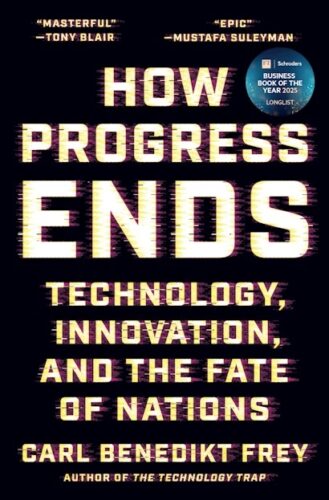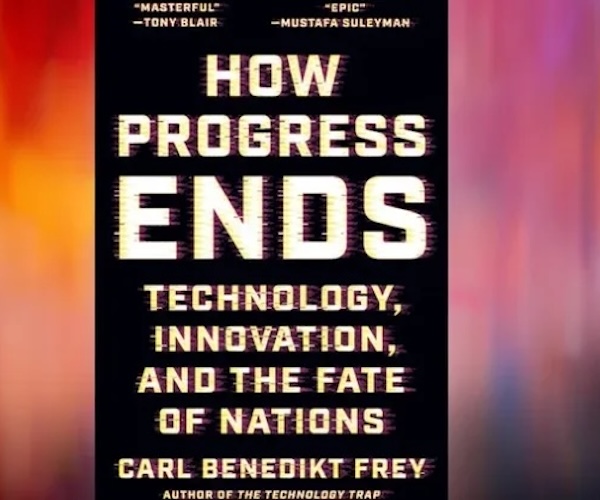By Jeremy Ray Jewell
As Martin Luther King Jr. said, “The arc of the moral universe bends toward justice.” Rather than ask how progress ends, shouldn’t we be asking how progress bends?
How Progress Ends: Technology, Innovation, and the Fate of Nations by Carl Benedikt Frey. Princeton University Press, 552 pages, $35

Carl Benedikt Frey’s book How Progress Ends explores a bedeviling paradox. Technological innovation has driven growth that has reshaped societies for millennia, but progress has been shown to be neither steady nor inevitable. Some civilizations surge ahead while others stagnate or collapse. Why? Frey looks into what causes progress to accelerate and to end. He argues that the interaction between political institutions and economic structures, along with the inevitable tension between centralization and decentralization, largely determines the unpredictable outcomes. The book also frames technological development as cyclical. Centralized bureaucracies excel at speed—exploiting established technologies and scaling them rapidly; decentralized systems are better suited for experimentation. The challenge for societies is to adapt as they move from one phase to another. Failure to adapt breeds stagnation.
In the opening chapters, Frey insists that progress hinges on dynamic efficiency. He admires the capacity to generate and test new ideas rather than the efficiency of existing production. Innovation often arises from the ideas hatched in informal social networks — English coffeehouses or American saloons. Suppressing these spaces (as in U.S. Prohibition), hinders invention because it disrupts informal collaboration, evidenced by a drop in patenting rates. Breakthroughs like the mRNA vaccines stem from decades of decentralized, uncertain experimentation. Frey even points to Silicon Valley as a product of decentralized dynamism, but here the narrative risks veering into myth-making: Google, often celebrated as the poster child of scrappy startup culture, succeeded not through pure garage tinkering but by buying its competitors with substantial venture backing from Sequoia and Kleiner Perkins before going public. This was a story of consolidation backed by deep-pocketed institutions — not a grassroots triumph of “small is beautiful.”
The second part of How Progress Ends consists of case studies: Ancient China pioneering inventions and bureaucracy, but eventually turning to state power, driven by taxation and war, which stifled grassroots innovation through centralization. In contrast, Europe’s political fragmentation, post-Roman Empire, fostered competitive pluralism and intellectual diversity. Dissenters were allowed to migrate, their ideas circulating across shared cultural and religious frameworks. These conditions helped ignite the Scientific Revolution.
Frey’s later chapters trace the rise and limits of bureaucratic planning. Both capitalist and communist states achieved rapid postwar growth through centralized coordination, but these efforts stagnated because rigidified institutions failed to adapt to technological change—especially in the USSR, which couldn’t replicate Silicon Valley’s decentralized innovation. By the 1980s, growing bureaucratic centralization faltered across East and West: corporate incumbents stifled any disruption to their dominance. Globalization and digital technologies concentrated innovation in a few large firms, leading to a slowdown in productivity and creativity—what Frey calls “The Great Flattening.” He also explores progress and authoritarian regression, contrasting China’s AI-driven surveillance state with the USSR’s. He suggests that, while authoritarianism can deliver short-term technological gains, the kind of iconoclastic innovation needed for long-term progress is diminished.
In his conclusion, Frey warns that both the U.S. and China may be drifting toward stagnation, despite surface-level transformation, because of institutional dysfunction. The epilogue reflects on the uncertain future of AI, emphasizing that the power of its impact on progress will depend on whether institutions foster openness or control.
How Progress Ends posits that progress depends on an expansive landscape. Technological growth not only depends on inventions, but also on the political and institutional ecosystems that allow them to flourish. History shows that progress ends when institutions designed for one stage of development persist into another. If the future is going to be about moving forward, rather than standing still, sustaining innovation requires protecting openness, decentralization, and competition—even at the cost of short-term inefficiency.
Frey’s exploration-exploitation dialectic highlights important institutional tensions, but it remains tethered to particular assumptions. The notion that large firms or state bureaus are necessary for the concentration of forces needed for the “exploitation” of technology ignores how technology undercuts this belief. One of the core insights of labor history is that industrialization created the material and organizational preconditions for labor unions. Why, then, should we assume more top-down extraction and accumulation, rather than envisioning models where workers democratically control production and its fruits? Doesn’t technology make that possibility more rather than less feasible? Frey’s argument falls short because of its grievous lack of political imagination: he doesn’t acknowledge that with each turn of the techno-screw we might be brought closer to ameliorating the problem of workers’ estrangement from their labor.
On top of that, Frey treats centralization by state or corporate actors as a necessary evil. And he romanticizes decentralization as inherently innovative. But, in reality, decentralization today often means the kind of gig work, with its attendant anxiety and isolation, that mitigates the conditions he believes are necessary for genuine innovation. His idea of contemporary “innovation” is nothing more than another run at the historic pattern of undercutting labor by shifting risk onto borderline contributors to the marketplace. In other words, he is not talking about empowering the marginalized, would-be pioneers of the new. What his book recommends is merely a revved up era of increased predatory extraction spurred on by a lack of real innovation in terms of how the innovators are treated.
Frey’s dichotomy casts the state as a top-heavy bureaucrat and the market as a nimble explorer. But this framing overlooks examples of how nationalizing or tightly regulating key sectors (energy, healthcare, infrastructure) can harness economies of scale while, at the same time, leaving room for the adaptability needed for invention. A key historical example: AT&T’s Bell Labs. The company’s golden age of transformation was sustained precisely because of a regulatory monopoly arrangement that cross-subsidized long-term research. In 1982, when the Department of Justice intervened, the issue wasn’t that AT&T was resisting disruptive technological change — Bell Labs was pioneering it. No, the problem was that AT&T was leveraging its local telephone monopoly to stifle competition in adjacent markets (long distance, equipment, data services). The company’s motive was not to stifle technology, but to monopolize its pursuit of profits and power. And, while the U.S. never explored creating a nationalized phone service, many other countries did — and with considerable success. National telecom monopolies in Europe and Asia built universal access, subsidized R&D, and even pioneered digital switching and early mobile technologies. These experiences undermine any simple link of “state centralization” with stagnation.
The Clinton administration’s Telecommunications Act of 1996 illustrates how misguided “market solutions” can be. Rather than investing in new infrastructure, the law spawned an extractive layer of resellers (CLECs) who leased old copper lines from incumbents, creating competition on paper that resulted in no discernible innovation. When the bubble burst, the U.S. was left with entrenched duopolies (telcos + cable) and one of the weakest broadband rollouts in the industrialized world. The tragedy is compounded by the fact that telecoms subsequently pivoted into the data-brokerage economy — harvesting client data through DNS resolvers, Deep Packet Inspection, and other surveillance tactics. From Bell Labs to robocalls: the arc of telecommunications bent toward monetizing attention and behavior rather than expanding technical frontiers.
If there is relatively little innovation to be had in a technology that has become a universal necessity, then nationalization becomes a reasonable option. On this point, Frey misses an opportunity to deal with a sensible challenge to his own argument: once technologies become universal necessities, the logic of ‘exploration vs. exploitation’ shifts, and exploitation may best be achieved through public provision, not fragmented, pseudo-markets. For instance, early ISPs had to fight through the inertia of telecom incumbents. Today’s social media “Baby Bells”—fragmented platforms like Truth Social and Bluesky—offer little in the way of technological progress while they entrench new forms of gatekeeping.
What unites all the objections raised to Frey’s argument is not innovation, but extraction: telecoms, ISPs, and social media have all converged into a monster that treats user data as a resource to be mined for profit. Whether through billing records, browsing habits, or engagement metrics, the imperative has not been about building new capabilities — it is increasingly about perfecting the machinery of surveillance and monetization. In that light, nationalization takes on an additional existential value — besides delivering more reliable services, it could also be instrumental in protecting citizens from being endlessly harvested as products.
To his credit, Frey warns of the authoritarian pitfalls in AI’s centralization. But, rather than talking about private or state-monopolized AI, why not consider building open, community-governed platforms? Make data and models a shared resource, with their operations guided by clear social objectives (education, healthcare, environmental management). That raises the possibility of making computational power a universal utility. But that may be the only way of seriously confronting the labor-displacing potential of AI: embed worker liberation in the design of the system’s algorithm, including a redefinition of work’s purpose beyond the exploitation of wage labor. As Martin Luther King Jr. said, “The arc of the moral universe bends toward justice.” Rather than ask how progress ends, shouldn’t we be asking how progress bends?
Jeremy Ray Jewell writes on class and cultural transmission. He has an MA in history of ideas from Birkbeck College, University of London, and a BA in philosophy from the University of Massachusetts Boston. His website is www.jeremyrayjewell.com.

